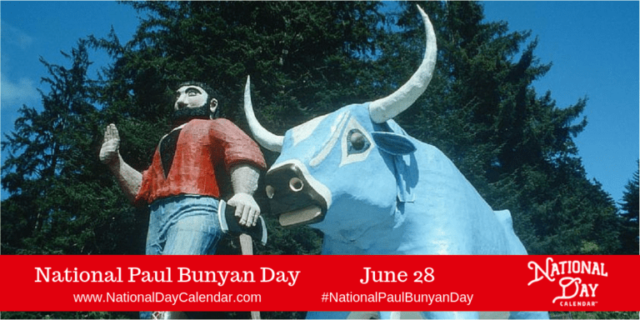
On June 28, we remember fondly the tales of the big blue ox and a mighty lumberjack. It is National Paul Bunyan Day!
Described as a giant and a lumberjack of unusual skill, Paul Bunyan is one of the most famous North American folklore heroes. In the tales, Paul Bunyan was almost always accompanied by his companion, Babe the Blue Ox.
- 1800s – Lumberjacks all over the Northeastern United States and Eastern Canada tell tales about a lumberjack named Paul Bunyan.
- 1837 – One account states that the tales began during the Papineau Rebellion of 1837.
- 1875 – French-Canadian logger, Fabian “Joe” Fournier’s murder in this year — and the subsequent trial of his alleged killer — spawns theories that he was the inspiration behind Paul Bunyan’s character.
- 1906 – First appearing in print in 1906, in a story published by Northern Michigan journalist James MacGillivray, Bunyan’s character originated in folktales circulated among lumberjacks in the Northeastern United States and Eastern Canada.
- 1910 – Journalist James MacGillivray shares a collection of stories about Bunyan while working at the Detroit News Tribune.
- 1912 – James MacGillivray collaborates with a poet to create a Paul Bunyan-inspired poem for “Lumberman” magazine.
- 1914 – K. Bernice Stewart first documents the original Bunyan ‘tall tales’, gathering these stories from local loggers while studying at the University of Wisconsin.
- 1916 – Adman and freelance writer William Laughead creates a promotional pamphlet for the Red River Lumber Company using Paul Bunyan as their ‘face’ — this campaign greatly embellishes the character’s exploits and adds more details and factors, like Paul’s immense size and Babe the Ox.
- 1922 – It was the 1922 edition of Laughead’s tales that inspired many others and soon the character’s plaid shirt and far-fetched characteristics spread across all of the United States and Canada.
- Many cities in the north-central section of the United States, claim the title as the official home of Paul Bunyan.
- Historians think his story could be based on the travels of Fabian Fournier, who was a 6-foot-tall lumberjack that traveled all over the country working.
- One Paul Bunyan legend claims it took five storks to carry him as a newborn. As he grew a little older, when he clapped his hands and laughed, windows shook and shattered. The story continues that he sawed off the legs of his parents’ bed in the middle of the night when he was only seven months old.
- Folklore also credits Bunyan with forming the Grand Canyon as he and Babe the Blue Ox walked through dragging his axe behind him.
- He also formed Mt. Hood when piling rocks on top of his campfire.
- Legend has it that the 10,000 lakes of Minnesota were formed from the footprints of Babe and Paul when they got lost in a snow storm.
- Babe the Blue Ox was a gift from fellow woodsmen Davy Crockett and Daniel Boone.
- At the Trees of Mystery attraction in Klamath, California there is a 49-foot tall statue of Paul and a 35-foot statue of Babe the Blue Ox.
- One day, as Paul was leading Babe down a treacherous road with a heavy tank of water in tow, the container sprung a leak, which trickled southward and eventually formed the mighty Mississippi.
- In The Bunyans, children’s book author Audrey Wood claims that what are arguably the world’s best-known waterfalls were formed when Paul’s feisty toddlers got dirty and had to be bathed in the Niagara River, though it’s unknown if this story was first told by modern yarn-spinners or their nineteenth-century counterparts.
- After camping in northern Oregon, Paul decided to extinguish his fire by smothering it with a pile of rocks, which have since been dubbed “Mount Hood.”
Sources:













[…] An uncredited 1904 editorial in the Duluth News Tribune is considered to be the earliest recorded story of Paul Bunyan. In 1906, journalist James MacGillivray wrote the first story, “Round River,” printed about this larger-than-life lumberjack. “In 1912, MacGillivray collaborated with a poet on a Bunyan-themed poem for American Lumberman magazine,” which finally gave national exposure to Paul Bunyan. “It was the 1922 edition of Laughead’s tales that inspired many others and soon the character’s p….” […]